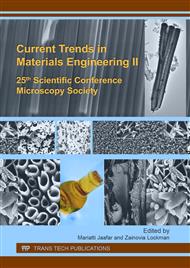p.25
p.29
p.33
p.38
p.42
p.46
p.50
p.54
p.58
Polylactic Acid Scaffold Fabricated by Combination of Solvent Casting and Salt Leaching Techniques: Influence of β-Tricalcium Phosphate Contents
Abstract:
β-tricalcium phosphate (β-TCP) is a ceramic that commonly been used in bone tissue engineering. This material exhibits low mechanical properties such as low fracture toughness and brittleness. To overcome these problems, polylactic acid (PLA)/ β-TCP scaffolds for bone tissue engineering were prepared by using the combination method of solvent casting and salt leaching. These methods were used to produce three-dimensionally interconnected pores of the scaffold according to different ratio of β-TCP with porogen agent (sodium chloride (NaCl)). It is found that porosity and pore size of the scaffolds were independently controlled by the ratio and the particle size of the added porogen. The increases of pore interconnectivity were observed with increasing of PLA/ β-TCP/ NaCl ratios. Scaffolds with 80-90 wt% of total porogen content displayed acceptable mechanical properties for bone tissue engineering applications. Morphology observed by scanning electron microscopy (SEM) revealed that highly porous three-dimensional scaffold (>80 wt%) with well interconnected porous structure could be achieved by this combination process.
Info:
Periodical:
Pages:
42-45
Citation:
Online since:
September 2017
Authors:
Keywords:
Price:
Сopyright:
© 2017 Trans Tech Publications Ltd. All Rights Reserved
Share:
Citation:


